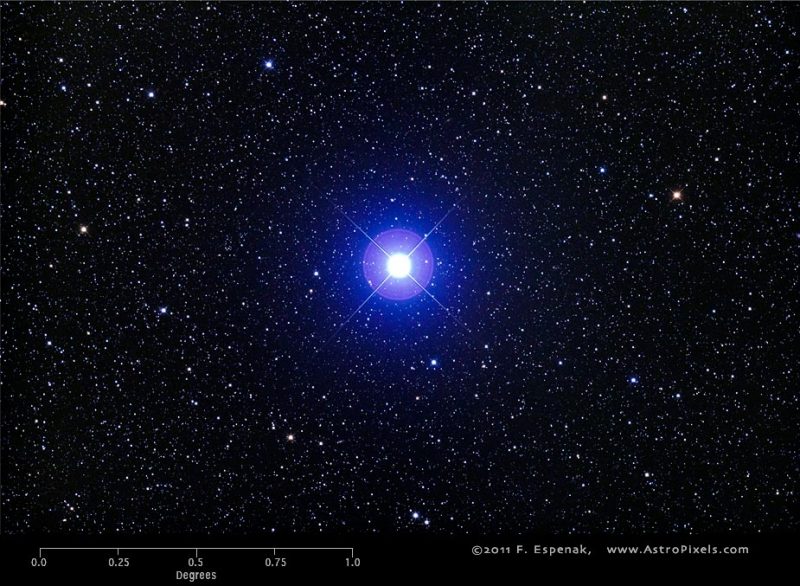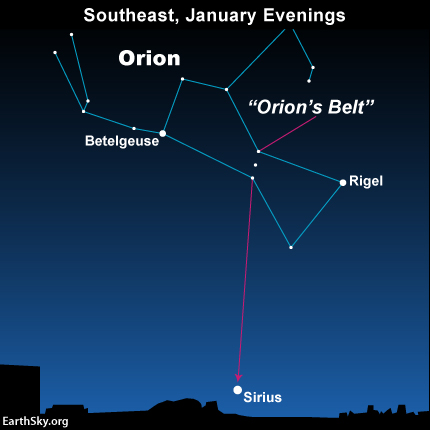
Tonight, as you look up at the stars, think about the direction our local star, the sun, moves through our Milky Way galaxy. Astronomers call the sun’s direction of motion through the Milky Way by a great old name. It’s called the solar apex or the apex of the sun’s way.
The solar apex is located in our sky in the direction of the constellation Hercules, southwest of the star Vega in the constellation Lyra the Harp.
Vega is a bright star. So you can look for it, and find it pretty easily. At this time of year from mid-northern latitudes, Vega appears over the northwestern horizon at dusk and early evening. Vega sets around mid-evening. It also appears low in the northeast sky in the predawn and dawn hours.
So look for the star Vega, and contemplate the fact that our sun and family of planets travel more or less toward it.
With its blue-white color, Vega also happens to be one of the loveliest stars you’ll ever see.

The blue-white star Vega is located near the apex of the sun’s way – our sun’s direction of motion through space. Photo via Fred Espenak at AstroPixels.com. Used with permission.
A friend from Australia wrote:
I seek to find out what speed our sun is traveling at and also how many years it takes to circumnavigate the galaxy.
Our sun takes a long time to circumnavigate the Milky Way, which is a collection of several hundred billion stars, with an estimated diameter of about 100,000 light-years. There are various estimates for the speed the sun travels through the galaxy, but its speed is in the range of about 140 miles per second.
Likewise, there are multiple estimates for the length of time it takes the sun to complete one circuit of the galaxy, but a typical estimate is about 230 million years.
That period of time – the length of the sun’s orbit around the Milky Way’s center – is sometimes called a cosmic year.
EarthSky lunar calendars make great gifts. Nearly sold out. Order now!

Vega is the brightest star in a famous star pattern known as the Summer Triangle. From mid-northern latitudes, as darkness falls on January evenings, the Summer Triangle sits close to the west-northwestern horizon.
By the way, our sun and planets travel more or less away from the star Sirius in the constellation Canis Major. Sirius is the sky’s brightest star. Not surprisingly, Vega and Sirius lie in opposite directions in Earth’s sky.
You can look for Sirius at this time of year, too. Remember, Vega resides almost exactly opposite Sirius. If you have an unobstructed horizon, this evening you might see Sirius low in the southeast, as Vega sits low in the northwest.
At mid-northern latitudes, you’ll possibly see both stars around 7 to 8 p.m. local time in early January. Sirius swings low in the southwest sky by around 3 to 4 a.m., at which time Vega reappears in the northeast sky (at mid-northern latitudes).

Use Orion’s Belt to find Sirius, the brightest star of the nighttime sky. From mid-latitudes in the Northern Hemisphere, you might see Sirius low in the southeast, as Vega sits low in the northwest.
Bottom line: Our sun moves around the center of the galaxy, toward the star Vega. Astronomers call this motion the apex of the sun’s way. One circuit – about 230 million years – is called a cosmic year.
from EarthSky https://ift.tt/2MRqxin

Tonight, as you look up at the stars, think about the direction our local star, the sun, moves through our Milky Way galaxy. Astronomers call the sun’s direction of motion through the Milky Way by a great old name. It’s called the solar apex or the apex of the sun’s way.
The solar apex is located in our sky in the direction of the constellation Hercules, southwest of the star Vega in the constellation Lyra the Harp.
Vega is a bright star. So you can look for it, and find it pretty easily. At this time of year from mid-northern latitudes, Vega appears over the northwestern horizon at dusk and early evening. Vega sets around mid-evening. It also appears low in the northeast sky in the predawn and dawn hours.
So look for the star Vega, and contemplate the fact that our sun and family of planets travel more or less toward it.
With its blue-white color, Vega also happens to be one of the loveliest stars you’ll ever see.

The blue-white star Vega is located near the apex of the sun’s way – our sun’s direction of motion through space. Photo via Fred Espenak at AstroPixels.com. Used with permission.
A friend from Australia wrote:
I seek to find out what speed our sun is traveling at and also how many years it takes to circumnavigate the galaxy.
Our sun takes a long time to circumnavigate the Milky Way, which is a collection of several hundred billion stars, with an estimated diameter of about 100,000 light-years. There are various estimates for the speed the sun travels through the galaxy, but its speed is in the range of about 140 miles per second.
Likewise, there are multiple estimates for the length of time it takes the sun to complete one circuit of the galaxy, but a typical estimate is about 230 million years.
That period of time – the length of the sun’s orbit around the Milky Way’s center – is sometimes called a cosmic year.
EarthSky lunar calendars make great gifts. Nearly sold out. Order now!

Vega is the brightest star in a famous star pattern known as the Summer Triangle. From mid-northern latitudes, as darkness falls on January evenings, the Summer Triangle sits close to the west-northwestern horizon.
By the way, our sun and planets travel more or less away from the star Sirius in the constellation Canis Major. Sirius is the sky’s brightest star. Not surprisingly, Vega and Sirius lie in opposite directions in Earth’s sky.
You can look for Sirius at this time of year, too. Remember, Vega resides almost exactly opposite Sirius. If you have an unobstructed horizon, this evening you might see Sirius low in the southeast, as Vega sits low in the northwest.
At mid-northern latitudes, you’ll possibly see both stars around 7 to 8 p.m. local time in early January. Sirius swings low in the southwest sky by around 3 to 4 a.m., at which time Vega reappears in the northeast sky (at mid-northern latitudes).

Use Orion’s Belt to find Sirius, the brightest star of the nighttime sky. From mid-latitudes in the Northern Hemisphere, you might see Sirius low in the southeast, as Vega sits low in the northwest.
Bottom line: Our sun moves around the center of the galaxy, toward the star Vega. Astronomers call this motion the apex of the sun’s way. One circuit – about 230 million years – is called a cosmic year.
from EarthSky https://ift.tt/2MRqxin

Aucun commentaire:
Enregistrer un commentaire